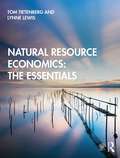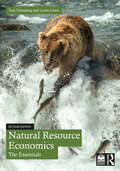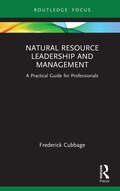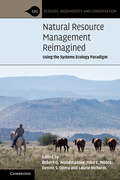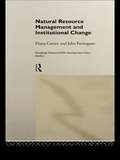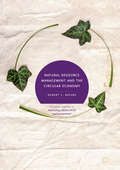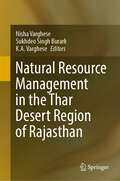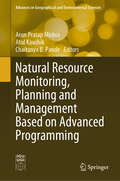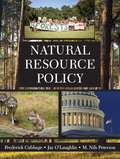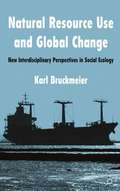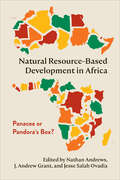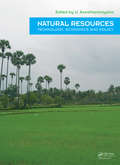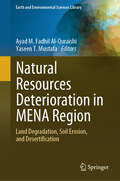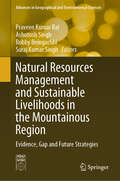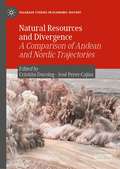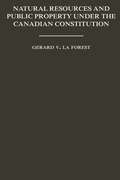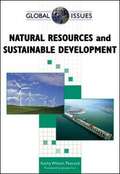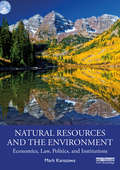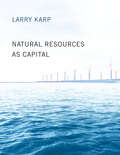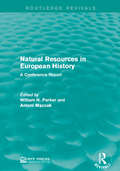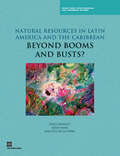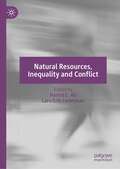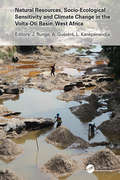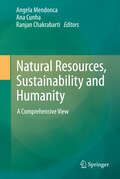- Table View
- List View
Natural Resource Economics: The Essentials
by Tom Tietenberg Lynne LewisNatural Resource Economics: The Essentials offers a policy-oriented approach to the increasingly influential field of natural resource economics that is based upon a solid foundation of economic theory and empirical research. Students will not only leave the course with a firm understanding of natural resource economics, but they will also be exposed to a number of case studies showing how underlying economic principles provide the basis for specific natural resource policies. Including current data and research studies, this key text also highlights what insights can be derived from the actual experience. Key features include: Extensive coverage of the major issues including energy, recyclable resources, water policy, land conservation and management, forests, fisheries, other ecosystems, and sustainable development; Introductions to the theory and method of natural resource economics including externalities, experimental and behavioral economics, benefit-cost analysis, and methods for valuing the services provided by the environment; Boxed ‘Examples’ and ‘Debates’ throughout the text which highlight global examples and major points for deeper discussions. The text is fully supported with end-of-chapter summaries, discussion questions, and self-test exercises in the book, as well as with multiple-choice questions, simulations, references, slides, and an instructor’s manual on the Companion Website. This text is adapted from the best-selling Environmental and Natural Resource Economics, 11th edition, by the same authors.
Natural Resource Economics: The Essentials
by Tom Tietenberg Lynne LewisNatural Resource Economics: The Essentials offers a policy-oriented approach to the increasingly influential field of natural resource economics that is based upon a solid foundation of economic theory and empirical research. Students will not only leave the course with a firm understanding of natural resource economics, but they will also be exposed to a number of case studies showing how underlying economic principles provided the foundation for specific natural resource policies. This key text highlights what insights can be derived from the actual experience.Key features include: Extensive coverage of the major issues, including energy, recyclable resources, water policy, land conservation and management, forests, fisheries, other ecosystems, and sustainable development Introductions to the theory and method of natural resource economics, including externalities, experimental and behavioral economics, benefit-cost analysis, and methods for valuing the services provided by the environment Boxed "Examples" and "Debates" throughout the text, which highlight global cases and major talking points. This second edition provides updated data, new studies, and more international examples. There is a considerable amount of new material, with a deeper focus on climate change. The text is fully supported with end-of-chapter summaries, discussion questions, and self-test exercises in the book, as well as a suite of supplementary digital resources, including multiple-choice questions, simulations, references, slides, and an instructor’s manual. It is adapted from the 12th edition of the best-selling Environmental and Natural Resource Economics textbook by the same authors.
Natural Resource Leadership and Management: A Practical Guide for Professionals (Routledge Focus on Environment and Sustainability)
by Frederick CubbageThis book examines leadership and management in natural resources, drawing on literature, principles, and the author’s own experiences as a leader and activist. Developing a general framework summarizing the leadership and management cycle in natural resources for practitioners, the book provides a synthesis of leadership theory and practice stemming from the personal and spiritual values of work, and the key principle of aligning organizational resources and actions with stated intentions. It discusses the somewhat unique context of natural resources, comprised of private and public goods and services and complex societal values. Key strategies that enable natural resource professionals to be leaders at all stages and positions in their career, including vision and sustainability, proficient human resources management, fairness and merit, and transparency and openness are analyzed. Case studies of famous natural resource leaders and activists, including Ding Darling, David Attenborough, Wangari Maathai, Marina de Silva, Greta Thunberg, Bob Brown, and Christina Koch, are included. The book examines their values, training, and principles and how they influenced national or global natural resource management. Drawing on the author’s own experiences as a leader and activist, including his role as Department Head at North Carolina State University, as an elected officer in the Society of American Foresters, and as an activist opposing the sale of the Hofmann Forest, the book provides practical examples and guidelines that professionals can consider and use in their careers. This book will be of great interest to natural resource managers and professionals as well as students studying environmental management and natural resource governance and to practitioners who are looking to develop broader leadership and management skills.
Natural Resource Management Reimagined: Using the Systems Ecology Paradigm (Ecology, Biodiversity and Conservation)
by John C. Moore Robert G. Woodmansee Dennis S. Ojima Laurie RichardsThe Systems Ecology Paradigm (SEP) incorporates humans as integral parts of ecosystems and emphasizes issues that have significant societal relevance such as grazing land, forestland, and agricultural ecosystem management, biodiversity and global change impacts. Accomplishing this societally relevant research requires cutting-edge basic and applied research. This book focuses on environmental and natural resource challenges confronting local to global societies for which the SEP methodology must be utilized for resolution. Key elements of SEP are a holistic perspective of ecological/social systems, systems thinking, and the ecosystem approach applied to real world, complex environmental and natural resource problems. The SEP and ecosystem approaches force scientific emphasis to be placed on collaborations with social scientists and behavioral, learning, and marketing professionals. The SEP has given environmental scientists, decision makers, citizen stakeholders, and land and water managers a powerful set of tools to analyse, integrate knowledge, and propose adoption of solutions to important local to global problems.
Natural Resource Management and Institutional Change (Routledge Research/ODI Development Policy Studies #Vol. 1)
by Diana Carney John FarringtonUsing new evidence from a three year programme of research in developing countries in Asia, Latin America and Africa, the authors describe how government organizations have been privatised, decentralised or restructured while private sector organizations - both non-profit and commercial - have taken on increasingly important roles in resource management and service supply. This book provides an important and easily accessible point of reference for decision-makers and students alike, offering unique view in its breadth of coverage across the natural resources sector and a range of different institutional types and approaches to resource management.
Natural Resource Management and the Circular Economy
by Robert C. BrearsThis book provides insight into how governments are using a variety of innovative fiscal and non-fiscal instruments to develop circular economies with significant economic and environmental benefits. It emphasises the urgent need for these circular economies and to move away from our current, linear model that has led to environmental degradation, volatility of resource prices and supply risks from uneven distribution of natural resources.Natural Resource Management and the Circular Economy illustrates how governments have promoted the development of an economy that can provide substantial net material savings; mitigate price volatility and supply risks; and improve ecosystem health and long-term resilience of the economy. Through a series of case studies, it details the various innovative policy instruments which can be utilised, including regulations; market-based instruments; incentives; research and innovation support; information exchanges; and support for voluntary approaches. The book also proposes a series of best practices for different countries, both developed and developing, who are implementing their circular economy.
Natural Resource Management in the Thar Desert Region of Rajasthan
by Nisha Varghese Sukhdeo Singh Burark K. A. VargheseThis book covers a wide range of issues related to the Thar Desert Region of Rajasthan from an integrated and sustainable development perspective. The chapters in this book cover regional and local issues which are discussed with reference to the past scenario, the present practices, and the future strategies. Some of the issues addressed in this book like arid agroforestry, livelihood, and multidimensional development give it a cutting edge over other related publications currently available in the market. The chapters are supported with relevant pictures which will help the reader to connect with the issues being discussed. This book is useful to students, civil services aspirants, researchers, environmentalists, geographers, and non-professionals who are interested in deserts and desert development.
Natural Resource Monitoring, Planning and Management Based on Advanced Programming (Advances in Geographical and Environmental Sciences)
by Chaitanya B. Pande Arun Pratap Mishra Atul KaushikThis book focuses on cloud-based platforms, advanced programming, machine learning models and programming approaches to assess water and other natural resources, flood impact, land use land cover (LULC), global forest change, global forest canopy height and pantropical nation-level carbon stock, among other areas. Sustainable management of natural resources is urgently needed, given the immense anthropogenic pressure on the environment and the accelerated change in climatic conditions of the earth; therefore, the ability to monitor natural resources precisely and accurately is increasingly important. To meet this demand, new and advanced remote sensing tools and techniques are continually being developed to monitor and manage natural resources effectively. Remote sensing platforms use various sensors to record, measure and monitor even minor variations in the earth's surface features as well as atmospheric constituents. This book shows how environmental and ecological knowledge and satellite-based information can be effectively combined to address a wide array of current natural resource management needs. Each chapter covers the different aspects of a remote sensing approach to effectively monitor natural resources and provide a platform for decision making and policy. The book is a valuable resource for researchers, scientists, NGOs and academicians working on climate change, environmental sciences, agriculture engineering, remote sensing and GIS, natural resources management, hydrology, soil sciences, agricultural microbiology, plant pathology and agronomy.
Natural Resource Policy
by M. Nils Peterson Frederick Cubbage Jay O'LaughlinNatural resource policies provide the foundation for sustainable resource use, management, and protection. Natural Resource Policy blends policy processes, history, institutions, and current events to analyze sustainable development of natural resources. The book's detailed coverage explores the market and political allocation and management of natural resources for human benefits, as well as their contributions for environmental services. Wise natural resource policies that promote sustainable development, not senseless exploitation, promise to improve our quality of life and the environment. Public or private policies may be used to manage natural resources. When private markets are inadequate due to public goods or market failure, many policy options, including regulations, education, incentives, government ownership, and hybrid public/private policy instruments may be crafted by policy makers. Whether a policy is intended to promote intensive management of natural resources to enhance sustained yield or to restore degraded conditions to a more socially desirable state, this comprehensive guide outlines the ways in which natural resource managers can use their technical skills within existing administrative and legal frameworks to implement or influence policy.
Natural Resource Use and Global Change
by Karl BruckmeierBuilding on recent developments in social ecology, this book advances a new critical theory of society and nature, exploring social metabolism and global resource flows in contemporary society. Barriers to global sustainability are identified and conditions for transforming industrial economies towards new sustainable resource use are described.
Natural Resource-Based Development in Africa: Panacea or Pandora’s Box?
by Nathan Andrews J. Andrew Grant Jesse Salah OvadiaThere is no question that Africa is endowed with abundant natural resources of different magnitudes. However, more than a decade of high commodity prices and new hydrocarbon discoveries across the continent has led countless international organizations, donor agencies, and non-governmental organizations to devote considerable attention to the potential of natural resource–based development. Natural Resource–Based Development in Africa places a particular emphasis on the actors that help us understand the extent to which resources could be transformed into broader developmental outcomes. Based on a wide variety of primary sources and fieldwork, including in-person interviews and participant observations, this collection contributes to both scholarly and policy discussions around the governance and economic development roles of local entrepreneurs, transnational firms, civil society groups, local communities, and government agencies in Africa’s natural resource sectors. Natural Resource–Based Development in Africa explores the impact that these actors have on regional trends such as resource nationalism and local procurement policies as well as grassroots-related issues such as poverty, livelihoods, gender equity, development, and human security.
Natural Resources - Technology, Economics & Policy
by U. AswathanarayanaNatural resources management has two principal dimensions : Science-illuminated (earth, space, hydrological, pedological, information, etc. sciences) management of local resources (waters, soils, bioresources, minerals, rocks, sediments, etc.) in an ecologically-sustainable manner, and Value-addition through processing of natural products, through
Natural Resources Deterioration in MENA Region: Land Degradation, Soil Erosion, and Desertification (Earth and Environmental Sciences Library)
by Yaseen T. Mustafa Ayad M. Fadhil Al-QuraishiLand deterioration, drought, desertification, and water resources shrinkage threaten natural resources, negatively impacting environmental, economic, and political stability. The increasing occurrence of climate change (extremes) impacts land degradation processes, soil erosion by water and wind, and salinization. The researchers have invested several years of scientific research in natural resources deterioration, including soil degradation and erosion, land degradation, desertification, and climate changes, which are interesting enough. However, the link between science and policymaking appears to be less active as serious actions do not take fast. The eighteen chapters of this book focus more on topics related to natural resources deterioration, such as land degradation, desertification, drought, climate change, and analysis of numerous case studies. This book presents experts' overviews, study results, experiences, and knowledge of natural resources deterioration in MENA countries. It attracts researchers, experts, scholars, scientists, academics, students, practitioners, graduates, or anybody interested in land degradation, desertification, climate change, and natural hazards that fall within natural resources deterioration. Therefore, researchers keep continuing to do their investigations and produce results that convince stakeholders and policymaking to act immediately towards protecting natural resources and their sustainability.
Natural Resources Management and Sustainable Livelihoods in the Mountainous Region: Evidence, Gap and Future Strategies (Advances in Geographical and Environmental Sciences)
by Praveen Kumar Rai Ashutosh Singh Suraj Kumar Singh Bobby BeingachhiThis book explores the relationships between natural resources management, sustainable livelihoods, and integrated watershed management in the context of the mountainous region, especially in the northeastern region of India. The book also sheds light on the current state of regional issues, identifies gaps in the existing practices and proposes future policies for effective conservation and sustainable development.The environmental degradation in the northeastern region of India is basically attributed to the increasing biotic pressure on the fragile ecosystems in the absence of suitable investments and proper management practices to enhance and conserve the natural resources. Population growth and poverty on the one hand and the pressure of rising demand from wealth and consumerism on the other hand, have been exerting powerful pressure on the ecosystems. Natural resources planning and management and sustainable livelihoods through integrated watershed management is not just a technical challenge; it is also a social challenge. The book is a valuable resource for policymakers, researchers, practitioners and stakeholders involved in natural resource management, sustainable development and watershed management in the Himalayan region.
Natural Resources and Divergence: A Comparison of Andean and Nordic Trajectories (Palgrave Studies in Economic History)
by Cristián Ducoing José Peres-CajíasIs the 'natural resource curse' destiny? Are different ways to link natural resources and economic development? Using two particular regions as case studies, this edited collection examines the divergent development paths of natural resource rich countries over the past two centuries. Bolivia, Chile and Peru are neighbour states with a common history and are globally known by their mining endowments. Norway and Sweden have also a strong common history, and different natural resource endowments (forestry, mining and fishing) are essential to understand their current economic success. By comparing natural resource management in the long run in these two divergent regions, this book can help rethink how developing countries can better take advantage of their natural resource endowments. Specifically, the book examines the interaction between natural resources and different key determinants of long-term development: trade, fiscal policy, sustainability, human capital accumulation and business strategies.
Natural Resources and Local Livelihoods in the Great Lakes Region of Africa
by An Ansoms Stefaan MarysseFragile but progressive post-conflict reconstruction has allowed for a new growth-oriented logic in the Great Lakes Region of Africa. However, the opportunities provided by economic development are not being equally distributed. A struggle exists between large-scale and local small-scale actors that is particularly prevalent in the rural environment, where the increasingly prevalent scramble for natural resources impacts heavily upon local livelihoods. This is occurring both in the agricultural sector and in the mineral sector. This book analyses the opportunities and constraints for local actors' participation in economic growth. The book first looks into the contemporary challenges with regard to land relations and local livelihoods in the Democratic Republic of the Congo (DRC), Burundi and Rwanda. It then goes on to consider the ambiguities that characterise the relationship between mining and development in the DRC. This book is essential reading for students, researchers and policy makers workingon rural development in Africa and those interested in understanding post-conflict reconstruction and the way in which local level dynamics relate to the broader political economy. "
Natural Resources and Public Property Under the Canadian Constitution (The Royal Society of Canada Special Publications)
by Gerard La ForestThe controversy aroused by the Supreme Court's decision on offshore mineral rights emphsizes the importance of the public domain in the workings of the Canadian constitution. Public property is important to the provinces not only for its revenues, but also because it provides them with a powerful instrument for control of their economic and political destinies and strengthens their position in relation to federal authorities. The provisions of the British North America Act and other constitutional instruments relating to natural resources and public property are examined thoroughly in this series of lectures given to doctoral systems at the Faulte de droit of the Universite de Montreal. Professor La Forest studies ownership of mines and minerals, navigable waters, public harbours, fisheries and Indian lands, as well as the currently controversial offshore mineral rights. He notes the political imlications of the partition of proprietary rights and explores the areas of conflict between the federal and provincial governments. Also included is a discussion of the power of expropriation, and, because public property involves public monies, lending and spending powers receive attention.In these lectures, Professor La Forest traces public domain in Britain from the time when the monarch controlled all the land, to his surrender of this control to parliament in return for a civil list, and to the similar surrender to the legislatures of the British North American colonies in connection with the struggle of responsible government.The collection of lectures is essential reading for any serious student of the constitution and will be very useful to all who are interested in the increasingly important law of natural resources in Canada.
Natural Resources and Sustainable Development
by Kathy Wilson PeacockJeremy Carl (Program on Energy and Sustainable Development, Stanford U.) introduces this volume by noting that whether development is viewed as more or less sustainable depends on how "sustainable development" is defined. Peacock (a generalist writer/ editor) presents a balanced introduction to this pivotal contemporary environmental, political, and social concept. Starting with factors contributing to the devastation of New Orleans by Hurricane Katrina, she examines issues of urbanization, over- consumption, and overpopulation from US and global perspectives. Written specifically with high school students in mind, the volume includes source documents, an annotated bibliography, chronology from prehistory to the near future, and a glossary. Annotation ©2008 Book News, Inc., Portland, OR (booknews.com)
Natural Resources and the Environment: Economics, Law, Politics, and Institutions
by Mark KanazawaNatural Resources and the Environment: Economics, Law, Politics, and Institutions provides a new approach to the study of environmental and natural resource economics. It augments current contributions from the fields of public choice, law, and economics, and the burgeoning field of what used to be called the "New Institutional Economics," to describe, explain, and interpret how these new developments have been applied to better understand the economics of natural resources and the environment. This textbook takes a multi-disciplinary approach, which is essential for understanding complex environmental problems, and examines the issue from not only an economic perspective, but also taking into account law, politics, and institutions. In doing so, it provides students with a realistic understanding of how environmental policy is created and presents a comprehensive examination of real-world environmental policy. The book provides a comprehensive coverage of key issues, including renewable energy, climate change, agriculture, water resources, land conservation, and fisheries, with each chapter accompanied by learning resources, such as recommended further reading, discussion questions, and exercises. This textbook is essential reading for students and scholars seeking to build an interdisciplinary understanding of natural resources and the environment.
Natural Resources as Capital (The\mit Press Ser.)
by Larry KarpAn introduction to the concepts and tools of natural resource economics, including dynamic models, market failures, and institutional remedies.This introduction to natural resource economics treats resources as a type of capital; their management is an investment problem requiring forward-looking behavior within a dynamic setting. Market failures are widespread, often associated with incomplete or nonexistent property rights, complicated by policy failures. The book covers standard resource economics topics, including both the Hotelling model for nonrenewable resources and models for renewable resources. The book also includes some topics in environmental economics that overlap with natural resource economics, including climate change.The text emphasizes skills and intuition needed to think about dynamic models and institutional remedies in the presence of both market and policy failures. It presents the nuts and bolts of resource economics as applied to nonrenewable resources, including the two-period model, stock-dependent costs, and resource scarcity. The chapters on renewable resources cover such topics as property rights as an alternative to regulation, the growth function, steady states, and maximum sustainable yield, using fisheries as a concrete setting. Other, less standard, topics covered include microeconomic issues such as arbitrage and the use of discounting; policy problems including the “Green Paradox”; foundations for policy analysis when market failures are important; and taxation. Appendixes offer reviews of the relevant mathematics. The book is suitable for use by upper-level undergraduates or, with the appendixes, masters-level courses.
Natural Resources in European History: A Conference Report (Routledge Revivals)
by Antoni Mączak and William N. ParkerNatural Resources in European History pulls together several papers from the Bellagio Conference on Natural Resources and Economic Development which took place in 1977. Originally published in 1978, this report focuses on papers exploring the history of natural resources in Continental Europe presenting research on how resources were traded, collected and depleted between the fifteenth and nineteenth century. This title will be of interest to students of Environmental Studies or with an interest in Environmental History.
Natural Resources in Latin America and the Caribbean: Beyond Booms and Busts?
by John Nash Augusto De la Torre Emily SinnottPolicy makers in many countries in the Latin American and Caribbean region have found it challenging to determine how to treat natural resource commodity production and how to manage the recurrent cycles of booms and busts. 'Natural Resources in Latin America and the Caribbean: Beyond Booms and Busts?' addresses the major concerns associated with commodity dependence, summarizing the state of the art in existing literature and filling in the knowledge gaps with new analysis. The report finds that some commonly accepted negative effects of dependence on natural resources are largely myths, while some are realities. But the authors find that all the effects can be managed, and they provide practical advice on how to do so. Issues covered include long-term fiscal growth, fiscal volatility, institutional impacts, and environmental and social effects. The report analyzes the implications for the region's development and policies. 'Natural Resources in Latin America and the Caribbean: Beyond Booms and Busts?' will be of interest to policy makers, academics, and analysts, as well as others interested in the economics of commodity markets and their role in economic development.
Natural Resources, Inequality and Conflict
by Lars-Erik Cederman Hamid E. AliThis edited volume explores the link between natural resources and civil conflict, focusing especially on protest and violence in the context of mining and the extraction of minerals. The primary goal of the book is to analyze how the conflict-inducing effect of natural resources is mediated by inequality and grievances. Given the topicality of the current boom in mining, the main empirical focus is on non-fuel minerals. The work contains large-N studies of fuel and non-fuel resources and their effect on conflict. It presents case studies focusing on Zambia, India, Guatemala, and Burkina Faso, which investigate the mechanisms between the extraction of natural resources and violent conflict. Finally, the book provides a summary of the previous analyses.
Natural Resources, Socio-Ecological Sensitivity and Climate Change in the Volta-Oti Basin, West Africa
by Jürgen RungeThis book presents the outcome of an interdisciplinary and international workshop supported by the Volkswagen Stiftung (funding line ‘Knowledge for Tomorrow’) on the topic of ‘Natural Resources, Socio-Ecological Sensitivity and Climate Change in the Volta-Oti Basin, West Africa’. The conference was jointly organised by Goethe-University Frankfurt (Germany) and the University of Kara (Togo) held from March 6 to 8, 2019 in northern Togo. It aimed to strengthen capacities of junior scientists from the sub-region, exchange and mobilise theoretical and methodological background from various scientific fields (Botany, Construction, Geology, Geography, Infrastructure, Politics, Remote Sensing, Sociology and Urban Planning). One goal was to deliver reliable elements for ongoing and profound environmental analyses that lie outside the common questions of the academic and civil society stakeholders. Ecosystem fragmentation and deforestation in West Africa are mainly triggered by humans such as agriculture and small-scale forest disturbances for charcoal and firewood production. Increasing population pressure, declining of carrying capacity and demand for agricultural land caused the reduction of land conservation capacities, even in protected areas. The complexity of interactions between environmental and socio-ecological systems and subsequent effects (sensitivity) has raised ongoing international awareness in light of ongoing climate change. By the example of natural resources, land use and stakeholders’ perceptions within the Volta-Oti Basin the book’s proceedings present, discuss and distribute new findings that will sustainably stimulate the international debate. The workshop also intended to overcome national borders and language barriers between the Anglophone (Ghana) and the Francophone (Benin, Burkina Faso, Ivory Coast, Togo) research communities, and supported better West African cooperation and networking. The young as well as the established partners formed new collaborations, and the event at the University of Kara (Togo) was a truly unique opportunity for all involved, not only to discuss science, but also to assess applied and best future management practices for the Oti-Volta Basin in West Africa.
Natural Resources, Sustainability and Humanity: A Comprehensive View
by Ana Cunha Angela Mendonca Ranjan ChakrabartiShortly, this book is the written up-graded version of the topics discussed during the Small Meeting of the 2nd International School Congress: Natural Resources, Sustainability and Humanity, held in Braga, Portugal, 5-8 May 2010 with the diverse participation of scientists, educators and governmental representatives. The Earth hosts an immense ecosystem, colonized by millions of species for billions of years but only for a few tens of thousands of years by humans. Environmental history tells though that it was humankind that shaped the environment as no other species. History, geography, religion and politics among other reasons have differentiated populations with respect to access to safe food and water, education, health, and to space and natural resource utilization. The globalization era of trade, information and communication is shortening distances and increasing overall wealth, but, as is pointed out in this book, it is also contributing to the propagation of diseases, and to the modification or even destruction of native ecosystems by exotic invasive species. Man is the only species that has the perception of its history, evolution, of the consequences of its decisions, and that there is a future ahead. It is also the only species that has the potential to change it. This awareness can be a source of anxiety and contradictory behaviours, but it is also the key to changing attitudes towards the construction of a common sustainable home, by committed education, interdisciplinary approaches, mobilization and empowerment of people and political consonant actions.
